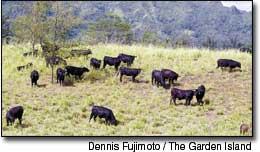Plans are under way to build a cattle facility in Puhi that will greatly assist ranchers in shipping live stock off-island. The three-acre facility will allow local ranchers to identify, either through tag or microchip, weigh, and hold, cattle for
Plans are under way to build a cattle facility in Puhi that will greatly assist ranchers in shipping live stock off-island.
The three-acre facility will allow local ranchers to identify, either through tag or microchip, weigh, and hold, cattle for shipping.
The facility is expected to be of particular assistance to smaller ranchers currently lacking all-inclusive facilities for shipping.
“It will help the little guy who might not have enough calves to fill a whole container,” said Lincoln Ching, county extension agent for the University of Hawai’i Cooperative Extension Service in the College of Tropical Agriculture and Human Resources.
“We currently are in the process of planning the facility, the cost, the construct of chutes. It’s progressing slowly,” he said.
The facility will have a receiving port, holding port, water facilities, and a livestockloading area.
Kauai Cattlemen’s Association (KCA) President Sheila Louis, who with her husband Jerry operates Louis Ranch 44, said she estimated many of the KCA’s 37 members would utilize the proposed facility.
Louis said she and her husband, who currently have 83 head of cattle, would use the facility.
She said fencing and water were in place, but that the holding pens needed to be designed.
Planning-committee members for the KCA have been meeting to discuss the project.
One goal of the new facility is to relieve congestion in the Nawiliwili Harbor area.
Ching said project planners have benefited from a $10,000 grant from officials in the county Office of Economic Development, and will be looking for matching in-kind contributions from member ranchers to see how the facility will be best maintained in the future.
Bobby Ferreira, a 25-year veteran of cattle breeding and KCA vice president, said he expected 25 to 30 ranchers would utilize the facility.
Ferreira said the KCA would be meeting Saturday, June 4 with leaders of the Hawaii Cattlemen’s Association (HCA), the KCA’s governing body, to determine a direction.
Louis said it was her hope KCA membership would cooperate, and work together to expedite the completion of the Puhi project.
“You can’t have a cattle business without a facility to ship them from,” said Alan Gottlieb, an HCA board member.
“Shipping cattle (off-island to slaughter) is the life line of the business,” he said.
Ching said local ranchers are looking at a challenging industry with fluctuating prices.
He said prices for local ranchers have been higher recently because leaders in Canada stopped importing beef due to concerns about bovine spongiform encephalopathy, more commonly known as mad-cow disease.
“I think it might be an incentive for producers to enter the business,” Ching said.
Ferreira said right now the Kaua’i-to-Mainland beef cycle was at a good point. He said when that changes, for whatever reason, local beef producers need to have a local brand market for their product, something he said would take a long time to build.
According to the Hawaii Agricultural Statistics Service, the number of cattle farms on Kaua’i increased 20 percent from 1999 to 2003, from 100 to 120.
But business volume has been down. In 2003, statewide beef sales were valued at $17.2 million, down from $18.3 million in 2002, according to the National Agricultural Statistics Service, Hawaii Agricultural Services
In 2002, Kaua’i beef sales were valued at $1.44 million. In 2003, the amount decreased to $912,000.
Ching said he could not account for the decline. He said it was his feeling the numbers were back up during the past two years because more pasture land had been dedicated to cattle ranching.


